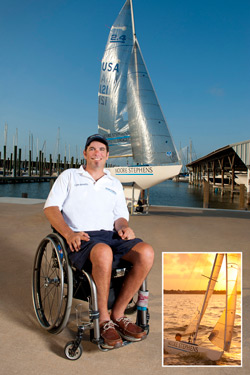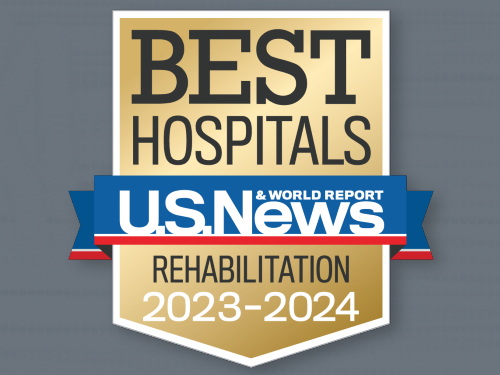Most physical medicine and rehabilitation professionals agree that full participation in society – or community integration – is the ultimate goal of rehabilitation. While much has been written on the topic, defining what community integration means to the individual learning to live with a “new normal” remains a challenge.
Lex Frieden, director of the Independent Living Research Utilization (ILRU) program at TIRR Memorial Hermann and one of America’s preeminent disabilities activists, offers an expanded view of the term. “We say community integration involves enabling the individual with impairment to live successfully in the community and participate fully in all aspects of community life. To me this means more than a return to doing what we loved to do before the illness or injury. It’s being able to do anything we choose to do, no matter how wild and crazy it is – without barriers. This is why we encourage patients from the day we meet them to think about life in the community as opposed to life in a facility. That’s the outcome we seek, and I believe TIRR Memorial Hermann achieves a greater level of success in meeting that objective than any other rehabilitation program in the country.”
TIRR Memorial Hermann therapy programs are focused on helping people develop the necessary physical abilities and, even more importantly, the problem-solving skills they’ll need to find ways to adapt to whatever restrictions they encounter as a result of disability.
For most patients, the inpatient rehabilitation experience is a pivotal transitional moment when family, caregivers and clinicians provide the support the individual needs to access the community and engage fully in life. “Most of our inpatients have not been home yet with their new diagnosis or new impairments,” says Rhonda Abbott, PT, administrative director of therapy services and clinical programs. “We’re asking them to make decisions about their goals and their future, and they may still be absorbing what’s happened to their bodies. They come to us from acute care and hope and expect they’ll be able to do all the same things they could do before the accident or illness. It’s our job to stabilize them medically so they can begin working on those tasks – and to help them begin to consider how their lives will be different when they leave our protected hospital walls. The inpatient experience is the first moment the patient, family members and clinicians get to consider what this new normal might look like. Patients begin incorporating their life goals into their new selves and learning how to live in the community in a new way. Resilience is an important determinant of their success. You may have family support, financial support and transportation, but if you have low resilience you won’t have the desire to get out of bed. Resilience shapes how patients will cope with the barriers they’ll inevitably face.”
Frieden, professor of health informatics at UTHealth School of Biomedical Informatics and an adjunct professor of physical medicine and rehabilitation at Baylor College of Medicine, points to the importance of problem-solving skills in achieving successful community integration. “Disability creates barriers that people without disability don’t have, and those barriers require them to live differently,” he says. “Patients who have the best outcomes are those who have innate problem-solving skills or can acquire them. TIRR Memorial Hermann therapy programs are focused on helping people develop the necessary physical abilities and, even more importantly, the problem-solving skills they’ll need to find ways to adapt to whatever restrictions they encounter as a result of disability.”
People recovering from TBI have a hard time being independent in the community, returning to work or school and forming relationships,...
Much of the research conducted in the last decade by Angelle Sander, PhD, has focused on how to help survivors of traumatic brain injury (TBI) get back to the lives they love. In an article authored in 2010, she and two other TIRR Memorial Hermann researchers wrote that while community integration traditionally has been defined by three main areas – employment or other productive activity, independent living and social activity – “significant gaps remain in our understanding of factors that impact community integration and in our ability to intervene to improve participation for persons with TBI.”
As director of the Brain Injury Research Center at TIRR Memorial Hermann, Dr. Sander has led the two most recent cycles of the hospital’s Rehabilitation Research and Training Centers (RRTC) grant awarded by the National Institute on Disability and Rehabilitation Research. She believes that advances in clinical care have outpaced research. “It’s difficult to conduct a really well-designed study of the effectiveness of an intervention for TBI and as a result, there’s a gap,” she says. “We have evidence-based ways to document improvement of cognitive performance but we don’t have good evidence linking improvement of cognitive performance to improved community integration. Does a specific type of rehabilitative training that results in a change of behavior have a broader implication that improves the person’s participation in the community? We simply don’t know. To help close that gap, we’re currently doing studies at the Brain Injury Research Center using participation as an outcome measure.”

Individuals with cognitive and emotional impairment face the greatest challenge to successful community integration. “People recovering from TBI have a hard time being independent in the community, returning to work or school and forming relationships,” says Dr. Sander, an associate professor of physical medicine and rehabilitation at Baylor College of Medicine. “They’re dealing with brain injury-related issues and environmental factors, including a stigma against persons with cognitive impairment. It’s more difficult for them to get and keep jobs because they may not be able to present themselves as well as they did before the injury. They can be taught strategies to overcome memory and cognitive problems, but social communication skills are more difficult. People in their environment may not know about their injury and decide the person is too much in their space, for example, or makes inappropriate comments. We continue to work to find effective interventions through clinical trials and by reaching out into the community to find resources for people. Many of our studies have involved working with people in their homes.”
Ensuring that people recovering from brain injury have the ability to function optimally in their environment is the goal of the TIRR Memorial Hermann Challenge Program, which provides multidisciplinary services – physical therapy, occupational therapy, speech-language pathology, vocational counseling and neuropsychology services – that focus on community reentry skills critical for the transition to independent living, school, work or volunteer activities. The program has a 30-year track record of success helping people integrate into the community after brain injury.
“In the Challenge Program we address the physical, cognitive and emotional needs of our clients with interventions that have a direct carryover to the environment in which they’ll function,” says Jessica De La Rosa, PT, DPT, NCS, director of outpatient rehabilitation at TIRR Memorial Hermann Outpatient Rehabilitation. “Our vocational counselors work directly with employers, going on site to identify physical or emotional barriers to success. Any barriers are relayed back to the individual’s treatment team, and we discuss how to break down those barriers. By engaging the client, family members, employers and schools, we’ve been able to produce very high return-to-work and return-to-school rates. Our current goal is to reach out into the community and build more relationships with area businesses and work with them to provide adaptations for graduates of the program. Being integrated into the community relates to aspects of the environment as much as it does to participation in specific activities.”
Lex Frieden was a member of the World Health Organization panel that redefined disability as “a complex phenomenon, reflecting the interaction between features of a person’s body and features of the society in which he or she lives. Overcoming the difficulties faced by people with disabilities requires interventions to remove environmental and social barriers.”
“For many people community integration is closely tied to their ability to return to work, and that depends on employers who can see beyond the disability to the ability,” Frieden says. “More employers today value diversity than ever before, but the reality is that there are more than twice the number of people with disabilities who are capable and qualified and not employed, than those who do not have disabilities.”
Through ILRU, TIRR Memorial Hermann operates the Southwest ADA Center, one of 10 regional centers that provide technical assistance and training on the Americans with Disabilities Act (ADA) to employers, architects, builders and community leaders who have questions about how to meet ADA requirements. ILRU also works with centers for independent living around the country and organizations for people with disabilities to help them build empowerment programs, self-help programs and peer-support programs.
“Thanks to the progress we’ve made since the passage of the ADA, more people are able to reach the goal of full community participation, which is one of the principles on which TIRR Memorial Hermann was founded,” Frieden says. “It takes time for people to be comfortable with their new normal. We help them through therapy, coaching and peer counseling, and community-based experiences. The individual has to set a personal goal of full participation and the community has to be conditioned to support people with varying levels of ability. Now 25 years after the ADA we’re at the point where the community is becoming barrier free – environmental barriers are disappearing and attitudes of employers, leaders and the public are changing. People are living longer, which means that more of us will face the issue of disability. Everyone has a contribution to make. As more people recognize that, we’re reaching the point where all of us can be part of the community and equally so.”
Sander AM, Clark AN, Pappadis MR. What is Community Integration Anyway?: Defining Meaning Following Traumatic Brain Injury. Journal of Head Trauma Rehabilitation. 2010 Mar-Apr;25(2):121-7.
